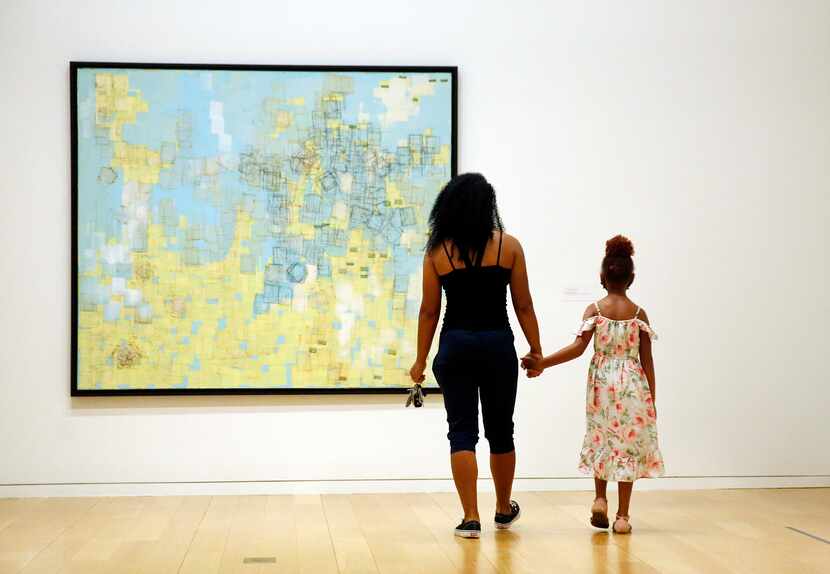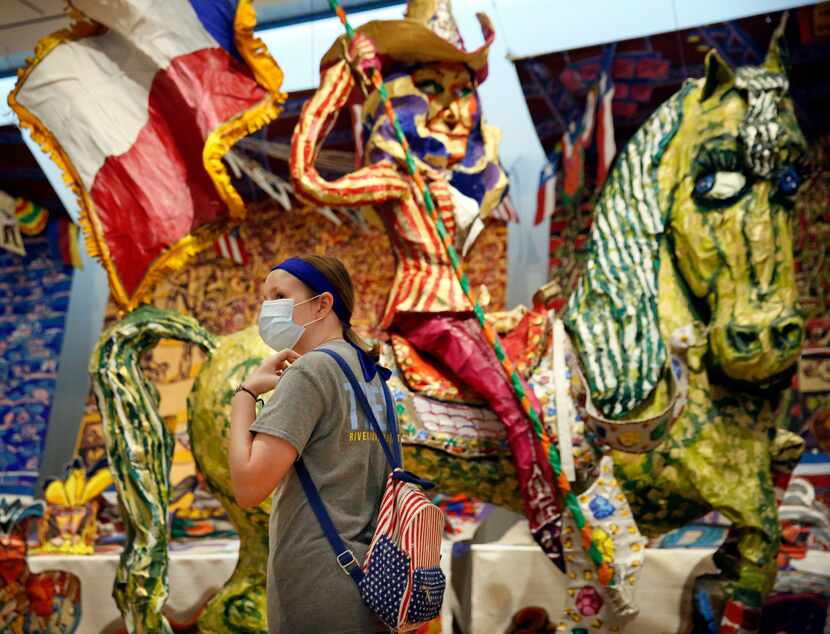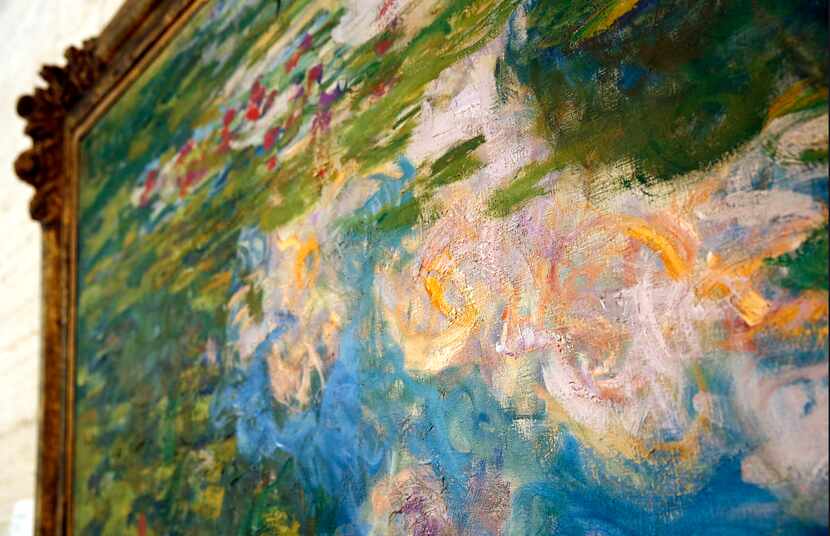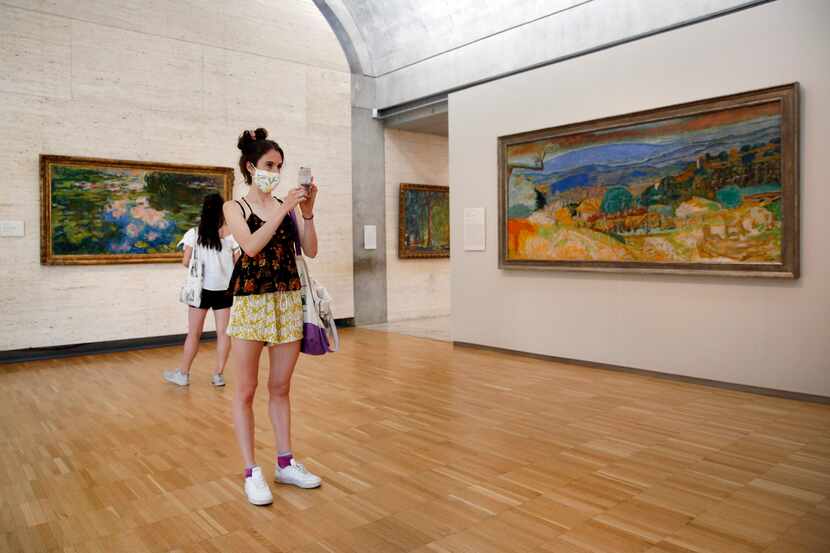I forgot how purple the color purple can be.
I forgot the way a color can enter your eyeballs and swell in your throat or inflate your lungs. Or the way, if you look closely, you can imagine the strength or delicacy of a brushstroke as a painter swipes it across a canvas.
This is what I was thinking last Friday afternoon, while standing in front of Untitled (1961), a painting by abstract expressionist Joan Mitchell at the Modern Art Museum of Fort Worth. I have returned to look at this painting year after year.
Yet, four months after a statewide lockdown, it seems I had forgotten how much I love looking at art. I had forgotten how a painting can make you feel.
As the world reopens in fits and starts, art museums in North Texas have made cautious plans to allow visitors. After shutting down nonessential businesses in mid-March, Gov. Greg Abbott allowed museums to reopen in early May, but it wasn’t until June 20 that the Kimbell Art Museum was ready for the public. It was followed by other Fort Worth museums, the Amon Carter Museum of American Art and the Modern. Most museums in Dallas remain closed, though they’ve gotten together to make plans to reopen safely.
Just weeks before the closure, the Kimbell opened “Flesh and Blood,” which includes works by Renaissance artists Raphael and El Greco, among others. Similarly, the Modern opened “End Papers,” an expansive exhibition by abstract artist Mark Bradford. These exhibitions have been extended, as museums across the country have rearranged programming to allow for potential visitors, but also to follow American Alliance of Museums guidelines for the installation and deinstallation of art.
How art is handled and how it travels are just two of the many considerations museums have had to make in light of this highly contagious disease.
Since decades before we called it social distancing, I have been standing six feet apart from strangers at art museums. I’ve mastered the patient, nonverbal shuffle to take turns reading the placard and the polite approach to examine the small brushstrokes of a particularly detailed painting. Outside of the hands-on education centers, museums tend to be touch-free encounters. But no one can promise you complete safety during a global pandemic, and because of that, the museum experience has changed.

All three Fort Worth museums are employing clear signage to inform visitors of mask requirements and the need for social distancing and small groups. They’ve removed any paper flyers and stopped docent tours. They’ve added hand-sanitizing stations throughout the exhibit halls and clear plastic shields at ticket counters. Cafes are shut down, and gift shops have limited capacity.
The Modern’s cavernous galleries make distance easy; at the Kimbell and the Amon Carter, keeping your distance is slightly harder. Even still, the museums are following the recommendation of 150 square feet per person, and the rest is up to the visitor. Thus far, attendance numbers have been low, according to Kendal Smith Lake, the Modern’s director of communications, even on traditionally busy days.
At the Modern, the wild, immersive exhibit “Ruckus Rodeo,” a 1975 commission from New York-based installation artist Red Grooms, takes up the entirety of a 2,600-square-foot gallery, which I had all to myself on that Friday. It is a floor-to-ceiling display of larger-than-life cartoonish bucking broncos and rodeo-goers. It’s one of those exhibits that might encourage a friendly exchange with a stranger. “This is crazy, isn’t it?” you might ask. “Totally cool,” they might reply. But there are no strangers, certainly not within six feet.

It’s no secret that this pandemic will change the way many of our institutions operate for years to come. Museums are no exception.
The pandemic forced museums to get creative. All museums had to reimagine education programs, providing online resources, classes, workshops or, in some cases, even take-home kits.
Then there was programming. The Dallas Museum of Art moved Arts & Letters Live online and started a weekly community-building newsletter with virtual tours, poems and even recipes. The Modern, which has prioritized intimate, in-person experiences, screened video works from its collection and refreshed a somewhat stagnant YouTube channel to share artist lectures and its “Drawing from the Gallery” series.
“The silver lining is that museums were able to gain some wider audiences for what we do here,” Smith Lake says. “There were people from Europe watching the lectures who might not have known we existed.”

But the digital experience will never replace the physical. From a screen, it’s difficult to understand a work of art’s scale or nuance. The Nasher Sculpture Center understood this. In addition to launching digital programs, the Nasher created “Windows,” a series that displayed one work at a time in its street-facing vestibule. It featured work by local artists including Tamara Johnson, XXavier Carter and Kristen Cochran. It was part of what Nasher director Jeremy Strick called the museum’s efforts to be both hyperglobal and hyperlocal.
“You always try to be innovative or find new ways to do things or different things you might do. But this time, for everyone at the museum, we had to do that,” Strick says. “To have an opportunity to completely rethink how you operate and how you interact and how you can make a difference has been fulfilling.”
This pandemic will leave its mark on every aspect of the world it’s infecting, including art museums. It might be weeks, months or years before everyone feels comfortable setting foot inside a museum again. For those craving some color, some detail and some texture, museum doors are reopening. Just don’t forget your mask.


/cloudfront-us-east-1.images.arcpublishing.com/dmn/IC2YY2R63FDT5H7Q4SIPNKQX4Y.jpg)
/cloudfront-us-east-1.images.arcpublishing.com/dmn/PPC6MBCUZJDJ7A3GSUHO745LC4.jpg)
/cloudfront-us-east-1.images.arcpublishing.com/dmn/IYF5ZMECLVH5FLZOKHWIYTZKJ4.jpg)
/cloudfront-us-east-1.images.arcpublishing.com/dmn/IKEVT7U2N5CEJDF6DP2PGVVBJM.jpg)
/cloudfront-us-east-1.images.arcpublishing.com/dmn/ZFJWX63LQRF42Q2PTATHP6RPQY.jpg)